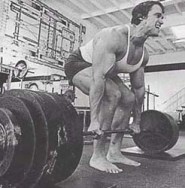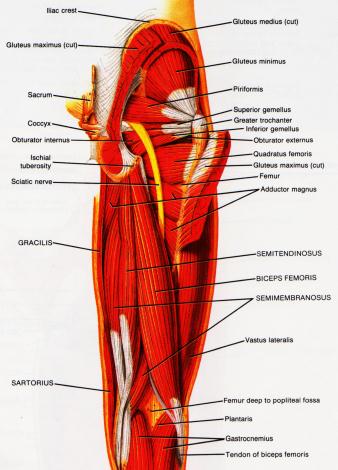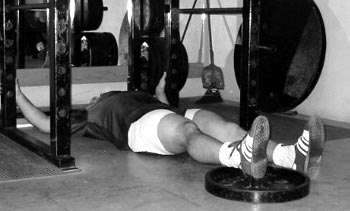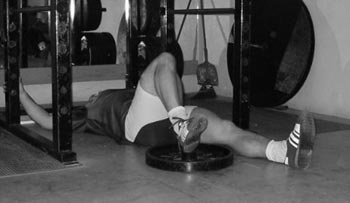
Serious fitness enthusiasts and athletes want to be able to lift thousands of pounds off the ground with minimal effort. It makes us feel good to be able to pick up anything we want. Especially when most guys in the world struggle to pick up even 100 lbs off the floor.
The number one way to make all these things happen? Train your hamstrings, lower back, and glutes (your bum) with complex free weight exercises.
Men and women alike should use these training tips. No amount of deadlifts are going to make a woman huge and bulky unless they TRY REALLY HARD to get huge and bulky on purpose. At the same time, no amount of body weight squats or lunges are going to get you big, strong, or conditioned. Train heavy and train hard, no matter who you are. And if you are a woman who is overly concerned about getting “too big” and just doesn’t want to lift weights, check out this mostly non-load bearing leg exercises for women to get an idea of some other exercises to work into a routine.
As I mentioned in my top 5 quad exercises post, your legs are the largest group of muscles in your body. By training your legs hard, you will be setting yourself up to gain the most progress compared to every other muscle group.
Strong hamstrings will allow you to:
- Pick up anything heavy off the floor or ground.
- Burn as many calories during training as you would when training quads.
- Form the foundation of your body’s posterior strength chain.
- Strengthen your lower back to protect from injury.
Anatomy of the Hamstring
Hamstrings sit on the back of the leg and run from the back of the knee up to the butt. They often work in conjunction with the glutes and lower back muscle for picking things up, and for core stability.
These muscles are not that easy to flex or to show, and because they are virtually hidden from view, novice trainers don’t put much emphasis on building the size or strength of their hammies. This is a grave mistake since strong hamstrings, glutes, and lower back are responsible basically for the health and stability of your entire body.
The hamstrings are made up of three main muscles:
- Biceps Femoris
- Semimembranosus
- Semitendinosus
These muscles all share an origin on the pelvic bone, under the glutes, and they attach to the tibia bone on the lower portion of the leg.
Biceps femoris has a short head and a long head. Long head attaches to the hip, while short head attaches as high as the insertion of the glutes.
Semimembranosus lies on the back and medial side of the thigh. It originates higher on the hip than biceps femoris and semitendinosus, and attaches to the medial condyle of the tibia.
Semitendinosus lies on the posterior and medial side of the thigh. It originates on the lower portion of the hip and inserts into the upper portion of the tibia.
Of related interest are the glutes and the muscles of the lower back.
 Hamstring Anatomy |
Functions of the Hamstrings
Hamstrings function to flex the knee and extend the hip. Knee flexion is the act of bringing your heels towards your backside, while hip extension describes a movement wherein your leg extends behind your hips.
Leg curls are an example of knee flexion and stiff leg deadlifts are an example of hip extension.
Glutes assist with extension, lateral rotation, and also abduction. The lower back muscles provide stability for the spine through all bending, lifting, and twisting movements.
Top 5 Best Hamstring Exercises
Of course squats and lunges are part of this list, but I intend to target exercises that train the hamstrings more directly. For more information on squats and other quad dominant leg exercises, see my post about the 5 best exercises for quads.
- Barbell Deadlifts
Deadlifts are one of the primary, fundamental exercises for all serious weight training programs. Deadlifts work 100% of your legs and they require functional stability from 95% of the rest of the muscles on your body. Using proper form, deadlifts will help you get stronger, gain more muscle, and burn more calories than any other single exercise after the squat.To set up: the barbell rests on the floor, sitting just above the ankles right in front of the shins. Your stance should be shoulder width for conventional deadlifts. Bending your knees, reach down and grab the bar so that your knees are actually inside your elbows. When going heavy, it helps to alternate your grip where one hand is pronated (palm facing you) and the other hand is supinated (palm facing away).
To deadlift: to start a deadlift, use your whole body to begin to lift the bar off the floor. Arms should be straight, knees should be bent. The object is to lift the weight with your legs, glutes, and hips, rather than with your lower back. In fact your lower back should not bend that much, should in fact be pretty straight, and should definitely NOT be rounded. You accomplish this by keeping your head up and by driving with your hips. It is of utmost importance to keep the bar close to your body during the lift.At the top you should stand up straight, but do not over extend your lower back as if you were doing some kind of hyper-extension. The driving force at the top should be more of a hip thrust than a lower back spasm. Lower the bar under control, keeping it close to your body.Variations: close stance deads, wide stance deads, sumo style deads, deads off a box, rack pulls or pin pulls, deads or rack pulls with chains or bands. - Stiff Leg or Romanian Deadlifts
Stiff leg deads are a compound exercise and one of the best mass building exercises for the hamstrings. Form is especially important to avoid becoming the next victim of lower back injury. Make sure to practice stiff leg deads with lighter weight until you master the form.To setup: setup similar to a conventional deadlift except that your feet should be set in a narrower stance and your knees should just barely be bent. Use a pronated grip until you get strong enough that an alternating grip is warranted.To stiff leg deadlift: Do not use your back! This should be another exercise where you drive with your hips and glutes using a straight back. The hips should move out and back to allow you to descend. Do NOT round your back or ‘bend over’ so to speak. Lower the weight down as far as you can without straining your hamstrings or compromising your spine.Romanian Deadlifts
The Romanian deadlift is another good compound ham exercise. Again, form is of essence. While similar to the stiff leg deads in the sense that you have to move your hips back during the descent, but the difference is that you can bend the knees a little more through the movement. This often allows one to go lower and lift heavier weight but takes some of the focus directly off the hamstrings. Romanian deads are a bit safer for the lower back.
- Good Mornings
Good mornings start like a squat but act like a Romanian deadlift. This is another great exercise for the whole posterior chain.To setup: the barbell rests on your upper back (traps) and shoulders (deltoids). It should not be sitting on your neck or spine. Bodybuilders tend to place the bar higher, while powerlifters usually hold the bar lower. The powerlifting style is my preference, and I recommend it because it allows you to keep your head and chest higher throughout the exercise, placing less stress on the lower back and neck.To good morning: keep your head up and your back completely straight. Bend at your waist with your knees locked but slightly bent. Ideally you will bend until your upper body is parallel to the floor, but this is not always possible for novice lifters. Return slowly to the upper position. Work on your form in order to bend over further while keeping your head up and back straight. - Glute Ham Raises
A little known exercise outside of powerlifting circles, the glute ham raise has been gaining popularity in recent years. Like the push up, pull up, and muscle up, this is a bodyweight exercise that really separates the men from the boys; the weak from the strong.To setup: firstly, you will need to anchor your feet. Find a lip on something, either a machine or a bed or one of those ab benches. Face down, you want to anchor your heels underneath the lip, and if you are not on a pad you will want to place a towel under your knees. Make sure the lip is not sharp or too hard as the pressure against your heels and achillies tendon will be great.To glute ham raise: starting with your feet anchored and your knees bent at 90 degrees, kneeling on the floor, slowly lower your upper body to the floor. You will probably need to catch yourself at the bottom, at least in the beginning, so you don’t smash your nose. Chances are you will also need to give yourself a slight push off the floor in order to get moving up again. This is a hard exercise and few people are good at it. Anyway, use your hamstrings to pull yourself back up to a kneeling position. - Standing 1 Leg Curls
Basically you take the lying leg curl, stand it up, and do it with one leg. The second best option is a lying 1 leg curl, since most gyms don’t have the standing leg curl machine. If you don’t have either of those machines, you could always resort to plate dragging.To setup and curl: climb on the machine and do a leg curl with one leg, then switch. That’s about all there is to it. This is especially an effective exercise for bodybuilders, but powerlifters and other athletes can do it too.Plate Drags
Thanks to T-Nation for this idea and for the images.
To setup: Hold on to something stable while lying on the floor. Extend your legs fully, placing the heel in the hole of a weight plate. Start off with lower weight and work up.
To plate drag: Slide the plate towards you by contracting the hamstring muscles of the working leg. The opposite leg stays extended. This should effectively mimic a leg curl, except that there is no negative or eccentric portion of the movement, which is actually good news because that means less micro-trauma and therefore less DOMS pain.
Plate Drag 1
Plate Drag 2
Honorable mentions: sled dragging, truck pulling, truck pushing, tire flips, sprints, one leg back extensions, and reverse hypers.
To use the exercise list optimally, you will want to choose 1-3 of these exercises to work into each workout. For full body workouts, choose only one exercise each day. In a 3 day split you would choose one conventional deadlift, one stiff leg or good morning, or one leg curl or glute ham raise for each day of that split.
If you use the outdated method of splitting up your body parts each day, choose 1 deadlift and either a glute ham raise or a leg curl for leg day. You will also have 1-2 quad dominant exercises to complete the leg day, so we can’t focus 100% of our efforts strictly on hamstrings.
Tags: deadlifts, exercise, good mornings, hamstrings, legs, workout routine











these exercises(glute ham raises,tire flips,one leg back extensions)how can be in gym without especially equipment?
Steve what is your opinion for the seated leg curl exercise.. is so good as well standing 1 leg curls or lying curls or plate dragging;
Not a huge fan of leg curls. If anything, I’d say the standing 1 leg curl would be best. Plate dragging is pretty sweet, but how are you dragging – with a sled? A sled is an awesome tool for leg training, especially for extra workouts and conditioning. They can also be used effectively for upper body training as well. Love sleds.
basicaly i meant if the seated leg curls is good alternative of standing 1 leg curls because my gym has the machine for the seated..also i ask the cable standing curls is better from the seated machine curls ?
Forget about all these leg curls, and stick to squats and deadlifts. If you must leg curl, just use whichever machine is available, but no matter what you won’t see results like squats and deads.
i just want to do all the best exercises that you have posted for every muscle group..and any exercise of them do not have the opportunity to do them I want to find alternative
that’s why i want your opinion and your help
nice
The fellow doing the deadlift in that video is a great example of terrible form.
I use all of these moves in my training routine. I still find the plate drag a difficult move for me. But will keep it in my program since it is such a great move.
Great thanks for sharing lots of tips on how to have a proper exercises. I really needed this kind of exercises for I am having trouble with my weight right now. Thanks again for sharing!
never saw the plate drag going to try that excersize today! got to work on the legs!
YEP
Stiff/Romanian Deads and GHRs are all I need for my hammies. GHR is also great with injury prevention due to the slow and controlled negative phase(the phase where most hamstring injuries occur).
The glute-ham raise has replaced the leg curl machine as my favorite ham exercise. It truly separates the men from the boys!
The glut/ham raise is awesome! I've never seen that before. I'm going to try it : ).
Id really appreciate it if you could tell me which exercise is fit for me. I want to lose a few inches around the waist and tighten up my butt just a little not that it’s really out of shape right now but yeah, sort of something like that! haha! I hope I can get a reply from Mr Steve! Thank you in advance…
Sounds like squats, lunges, and deadlifts are right for you. Don’t forget to train your upper body to balance it all out. Try my Fat Loss for Women routine.
Hi! I am a tattoo artist from the Philippines. There’s one client who had me tattoo his entire back. He was a body builder by profession and was from Australia. Before I started working on him, he took a pill which he said makes him able to tolerate pain. He said he takes it too before a very heavy work out at the gym in preparation for a competition. I want to ask about it, and if it is safe to use.
OK. I don’t know anything about it.
hey steve great article. i do legs and shoulders on the same day as part of a 4 day cycle(bi/back,legs/shoulders,chest/tris,cardio) how many legs exercises do you recommend i do and which ones should i do together on a specific day
I’m not sure I understand how deadlifts work hamstrings. It seems from the description that they would work quads more than anything. Could you explain it to me? I really want to include them in my workout but I think it would be better for me to fully understand them before I start them.
They work hamstrings mostly, quads slightly. The difference all has to do with the physiology of the push versus the pull. The hamstrings, glutes, and erectors work to extend or straighten the hip, which is the primary movement in the deadlift, along with knee flexion.
In the last year I have dropped about $3,000 on a personal trainer and I feel that my knowledge of strenght and muscle building exercises is about the same. And now that I’m trying to do it on my own, I certainly appreciate sites like this that help me better understand and practive the exercises. I hate working out but I got no other choice.
Of all the exercises in this write-up the one that is very useful and I am comfortable with is the Glute Ham Raises, with this kind of exercise I feel that I have Improved my muscles a lot. I also do the other exercises but I mostly do the Glute Ham Raises exercise.
I never train my hamstrings, will these exercises help to tone thighs and backside too? Or just the back of the legs?
that guy workng out that blonde chick has the best job ever, in the glute ham raise vid!
Thank you for the fast and informative reply Steve
Well, i don’t know if i can call them injured.. I had a serious car acc 12 years ago (yes that long).. Total body muscle atrophy..All muscles were geting stonger slooowly, all but hamstrings and inner thighs.. After some 2-3 years i stopped the effort (after some misleading, negative and simply wrong talk from doctors), and dealt with it, but a few months ago, they started to kick in.. ( can’t explain why )So i went to a new physiotherapist for a check after a friend recommended him.
What he said made me wanna punch EVERY doctor on sight.. “Kid, your hams and adductors are only weak, there is movement, the only thing you need to do is strengthen them..!!” You can imagine how my jaw hit the floor, and how im laser focused on making them strong as hell!
My hamstings and adductors are weak, meaning that if i lay on the floor i can’t even lift them up to the glutes without assistance(my knees hyperextend), but from a certain angle they can move ok.. Adductors are a bit stronger..
Sorry for the marathon post, any advice would be highly appreciated.. )
Best regards, Chris
Very nice post! 🙂
Would you be kind enough to suggest a training split that will strengthen atrophied hamstrings? i mean, how many days per week should i do them?
Physiotherapists are always like: every day, endless reps of curls.
Hamstrings are made of Fast Twitch Fibers, im a bit confused by what they say, so i ask for your opinion. How can they get stronger and bigger if you don’t progressively overload them?
Any input would be highly appreciated, take care! 🙂
Are you injured? If so, very high number of reps with light weight is best for physical therapy. It will stimulate blood flow and increase mitochondria in the muscle cells, just to name a few benefits, which will inevitably help repair damaged tissue and increase the intracellular efficiency. Once the injury has fully healed then it would be prudent to train the hamstrings every 48 hours using increasing resistance with linear progression for 3 sets of 8-12 reps to stimulate hypertrophy. After several weeks (3-4) of that you can really start to vary it up by using different exercises, heavier weights, maybe some deadlifts. At that time you might only be training your hamstrings once or twice a week, but with much more volume and intensity.
Disclaimer: definitely don’t jump into anything I’ve said if you are recovering from injury. Always listen to your doctor or physical therapist first.
Thank you for the fast and informative reply Steve 🙂
Well, i don’t know if i can call them injured.. I had a serious car acc 12 years ago (yes that long).. Total body muscle atrophy..All muscles were geting stonger slooowly, all but hamstrings and inner thighs.. After some 2-3 years i stopped the effort (after some misleading, negative and simply wrong talk from doctors), and dealt with it, but a few months ago, they started to kick in.. ( can’t explain why )So i went to a new physiotherapist for a check after a friend recommended him.
What he said made me wanna punch EVERY doctor on sight.. “Kid, your hams and adductors are only week, there is movement, the only thing you need to do is strengthen them..!!” You can imagine how my jaw hit the floor, and how im laser focused on making them strong as hell!
My hamstings and adductors are week, meaning that if i lay on the floor i can’t even lift them up to the glutes without assistance(my knees hyperextend), but from a certain angle they can move ok.. Adductors are a bit stronger..
Sorry for the marathon post, any advice would be highly appreciated.. :))
Best regards, Chris
Hi Steve. Since developing a rather severe back problem I’ve had to switch from running to cycling- which it turns out I like better anyhow. I am training to do centuries this summer! Of course, one of the things to focus on is hamstring strength. Hence my issue, and similar to what Tia asked is that I need to be able to do strength (Not worried about mass) exercises that will not have me lifting over 20Ibs (I’ve found that that’s the point for me, after that my feet go numb very quickly) and stuff that doesn’t have me bouncing around, twisting etc. Yeah, a lot of good core exercises just aren’t available for me ( a person who NEEDS core strength). Anyhow, if you were to post non-machine and non-dead lift options that would be fabulous!! I’ve enlisted the advice of reliable friends too. I won’t pick on your for the size 2 joke. It’s about confidence and good self image in the end.
Firstly, let me state that I am not licensed to provide workout routines for people with injuries, especially back injuries. You should consult your doctor or a physical therapist before using any advice on this website.
That being said, you might want to consider kettlebell circuits with their various pull-thrus, cleans, and snatches. To work hard on your core, I’d spend more time using ab exercises that move your legs or upper body through space. Lying exercises like the Superman would be good for you too.
Which of the exercises puts least strain on the lower back?
Plate drags and glute ham raises will put the least strain on your lower back. Also, don’t forget to stretch after training to ease any discomfort.
which one is better for the hamstrings regular deadlift or stiff leg deadlift
Depends on what your goals are, but for the most part the regular deadlift is best. Stiff leg deadlift is good for working a weak spot, increasing flexibility, and getting additional heavy hamstring work in without resorting to more sets of conventional deadlifts.
steve, one thing that would be very helpful to us novices (and i realize you do this for free) is to list the common mistakes that people make with these exercises that give inefficient results or lead to injuries … there may not be any, assuming a person is intelligent enough to read and follow directions, but especially with the lower back, form is critical … thanks for the videos, btw …
Thanks for the feedback frank!
Hello Steve im a big follower of all your workout routines. I currently have a quick question about BB Deadlifts and BB Shrugs. I recently bought lifting hooks from my local walmart for 10$ and i only use them on these 2 workouts. Are these lifting hooks as good as straps or are the hooks not as good as straps?
Thanks,
Cole
What do you think of “The Perfect Rep” article on the T-Nation website?
6 sets of 3 reps, “lower the weight as fast as you safely can”, among other things are what I’m concerned about.
I have thoroughly enjoyed The Perfect Rep. I’ve been training with explosive reversals and attempting to accelerate through lockout for years, but this article sums it up best. A must-read for everyone.
Really? I’m no expert at this game, but I’ve taken neurology and physiology classes this year and I must say all the stuff about the CNS sounds like a big piece of BS. You must admit there is no scientific foundation to what this article states. The article makes use of words that are incomprehensible to the general population, and since the author looks like he knows what he’s talking about, it makes the article look more credible.
That being said, this whole website seems very fishy to me.
27 lbs gained in 6 weeks? I don’t know man… How perfect can a rep be?
Whether the article is ‘right’ or ‘wrong’, it makes good points. I am a big believer is starting strength, reversals, and acceleration. What the Perfect Rep tries to explain, is that we can improve the lines of CNS communication by forcing our muscles to contract with maximal intensity and attempting to accelerate through the concentric portion of the rep. After studying physiology and experimenting with 100 different ways to execute reps, I personal have discovered that this type of training is very effective at increasing strength, speed, and power. I may have no idea what I’m talking about, and the guys at T Mag might be trying to sell us $100’s worth of supplements, but their training and nutrition advice is most often very useful and at least it stimulates thought and discussion.
ok, what if the glute ham raise hurts my knees?
will it cause them to hurt or are my bones just stupid and weird
Lesley: Are you using a pad or mat under your knees? Which machine or station are you using? What does the pain feel like? Where is the pain located within the knee?
This turned me off because of your opening paragraph about women. You come off as sexist, not every woman wants to fit into a size 2. I’m not roly poly but I’m not obese, there is a medium in between which many women such as myself fit in to. Minus what you had to say about women in the beginning the content was okay.
Sorry for offending you Amy. Every once in a while a female is angered by one of my posts. The reality is that America has the fattest women in the world. The other reality is that America has the fattest men in the world, and the fattest children in the world. I don’t discriminate and I can guarantee you I am not sexist.
Most women see actresses and supermodels and want to look like them, whether size 0, size 2, or size 5. I personally like my women with meat, and would much prefer a woman who wears a size 7 – size 9 than a size 1.
haha it is kinda funny you said you like your women with meat
tia, an article like that would take some research but I’ll put it on my list to consider for the future. Thanks for the feedback.
pat, you wish buddy. Only one lucky man got to work the spot on that exercise and it wasn’t me either.
oh my god… where was that video shot? I volunteer myself to be the spotter
[…] with a lot of hamstring exercises. Hope it helps! Hamstring Exercises | Hamstring Workouts The Top 5 Best Hamstring Exercises | Build Muscle and Lose Fat – Articles on Conditioning, Weightlif… Want The Best Hamstring Exercises Ever? __________________ To view links or images in signatures […]
can you make a top 5 list of good hamstring,glute,lower back excersizes that do not require equipment or machines?
thankyou vm, Tia 🙂
[…] Deadlifts to work our hamstrings. Deadlifts are #1 on the list of the 5 best hamstring exercises. […]
You can really tell you are in this seriously.
Great extensive post on the exercises for the specific bodyparts.
One thing that is sad but true is most people really concentrate on things like their biceps,triceps and abs and really pay small attention to the below the waist areas.
This is where great strength is achieved but slighted during workouts.
We have to hit those legs. nuff said